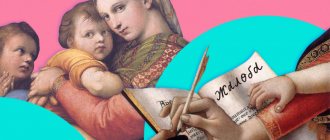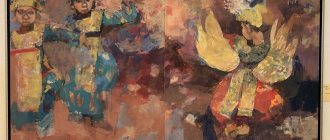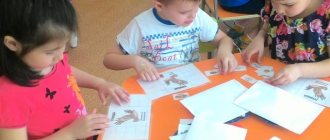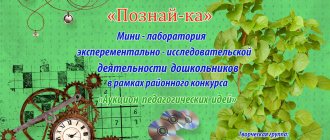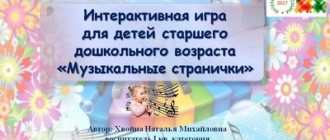Senior group. Senior preschool age. Children 5-6 years old
Mini-museum “Fabrics can do anything” in the senior group
Project Mini-Museum “Fabrics Can Do Anything”
Teachers: Blazhenkova Elena Efimovna, Izgagina Ksenia Sergeevna. Project type: educational and research. Project participants: group teachers, group students; parents. Relevance: modern children think that everything around...
Gatherings at the mini-museum “Good responds with kindness. Bazhov’s tale “The Blue Snake” (senior age) Venue: mini museum of kindergarten : “Russian Izba”
Topic: Mercy, kindness, responsiveness, obedience - disobedience, love - selfishness, responsibility, independence, happiness, understanding of loved ones, gratitude, friendship, mutual assistance, courage, support,...
Project “Mini-museum in kindergarten”
Lyudmila Proshkina
Project “Mini-museum in kindergarten”
Project " Mini-museum in kindergarten "
Developed by Lyudmila Viktorovna Proshkina, Deputy Head of Educational Work
Target setting for the implementation of the project “ Mini-museum in kindergarten ”
: Creating conditions for the development of the child’s personality by including it in the diverse activities
of the mini-museum .
This goal will allow us to solve the following tasks:
• to form the self-awareness of preschool children, the formation of their active life position, the ability to actively adapt to the world around them;
• develop children's creative, logical and creative thinking, speech, and vocabulary of preschoolers;
• develop cognitive abilities and cognitive activity of children, broaden the horizons of preschoolers;
• develop design and research skills ;
• to form joint activities between children and adults
• enrich the subject-developmental environment of the preschool educational institution.
Relevance:
As part of the modernization of education, the emphasis is on a person-oriented model of interaction between an adult and a child. The purpose of such interaction is to provide the child with a sense of psychological security, trust in the world, joy of existence, joy from his own discoveries, the formation of the beginning of his personality, and the development of his individuality.
Modern life is subject to a very fast pace; a person must adapt to everything very quickly. It is especially difficult for a child of preschool age, when he does not yet have much social experience. This pace of life leaves an imprint on his mental development and all his cognitive processes.
In this regard, the search for new models and forms of organizing all the activities of children in the conditions of education and training in a preschool institution becomes an urgent task. The education of a preschool child, first of all, should be based on the emotional, sensual side of his personality, which is associated with the characteristics of child psychology .
Museum pedagogy, which arose at the intersection of pedagogy, psychology, museology, and art, creates conditions for the development of a child’s personality by including it in a variety of activities, covering the emotional, intellectual, and activity spheres.
Museum pedagogy solves the problems of aesthetic, moral, spiritual, and patriotic education in an integrated manner. The forms and methods of its work contribute to the development and improvement of the communicative-speech, cognitive, creative competencies of a preschool child, his successful socialization in children's and then adult society. Implements the most pressing task of modern education today - to teach a child to learn and cognize.
Project participants : teachers, parents of students, children.
Project duration : (long-term)
Brief description of the material content:
Stages of the project “ Mini-museum in kindergarten ”
In the process of creating mini-museums, the kindergarten staff had to try themselves in the roles of designers, artists and the role of museum experts. All work can be divided into three stages.
Preparatory stage.
At the beginning of the school year, the teaching staff approved the proposal of the methodological service of the preschool educational institution to develop the project “ Mini-museum in kindergarten ”
and holding the
“Best
Mini-Museum ” . The team of each group: children, teachers and parents had to determine the theme and name of
the mini-museum , develop its model, and choose a location.
The methodological service has developed criteria for the competition for “Best mini-museum ”
, which were discussed with the teaching staff of the preschool educational institution.
Practical stage.
Adults and children, following their models, created mini-museums in groups . Parents played a big role in this process, bringing exhibits and helping with decoration. At the last stage of this stage, educators together with the children developed the content of excursions around their museum, and the preschoolers themselves proposed what exactly they consider necessary to tell about their mini-museums . Those who wished to become tour guides.
The mini-museums turned out to be different in design and content.
When creating mini-museums , we did not forget that, of course, the leading activity of preschoolers is and remains play. Therefore, in the independent activity corner, the child is given the opportunity to play creative games. didactic, role-playing, theatrical games.
In real museums you can’t touch anything, but in mini-museums it’s not only possible , but necessary! You can visit them every day, change them, rearrange exhibits, pick them up and look at them. In an ordinary museum, a child is only a passive contemplator, but here he is a co-author, the creator of the exhibition.
Forms of work in organized joint activities between the teacher and children included: practical experiments, development and production of collective and individual work-exhibits, exhibitions, joint events with the city museum.
Each mini-museum is part of a specific project . For example, the creation of a mini-museum “70 Years of Victory”
in the senior group it was part of an educational and research
project on moral and patriotic education “My Hero”
.
A lot of research work was carried out here to search for data about their relatives - participants in the Second World War. Excursions to the museum, a trip to memorable places, and extensive research work to find data about their relatives who participated in the Second World War were organized. Excursions to the museum, a trip to memorable places were organized, and the students of the group, together with their parents, took part in the Victory Parade; they marched in the “Immortal Regiment”
with portraits of their heroic relatives.
The interest of children and parents does not decrease; the created mini-museum continues to be replenished with new exhibits.
The mini-museums turned out to be different in design, content, and theme:
"Burenushka"
,
“Horses”
,
“Birds of our region”
,
“Wooden toy”
,
“Amazing shell”
,
“Flowers of Russia”
and others.
Determining the location mini-museum.
Various parts of group rooms and bedrooms were used to locate mini-museums One of the requirements for the location of museums is that each of them must fit into the interior of the premises.
a mini-museum in a group room contain ? This includes choosing a location, arranging exhibition items, making additions, and including children’s interests in the process of creating the interior of the exhibition. It all depends on the creative potential of the teacher, his ability to involve children and parents in the process of searching and collecting objects for a mini-museum .
The final stage
Holding a competition for “Best mini-museum ”
.
The design, content and originality of themes and exhibits were assessed. A map of the jury members was developed, printed and distributed to each member of the commission. The jury included the kindergarten administration and parents . “Best
Mini-Museum ” competition were determined , who were awarded diplomas by the pedagogical council.
The creation of mini-museums in preschool educational institutions makes it possible to:
— implement a non-traditional approach to education, based on children’s interest in research and search activities; combine emotional and intellectual methods of influencing children;
- reveal the significance and practical meaning of the material being studied;
- try your own strength and self-realization for each child in accordance with their inclinations and interests, to reveal their unique individuality;
- to form self-awareness, the formation of an active life position, the ability to successfully adapt to the world around us.
The preschooler develops an interest, and this is reflected in his thoughts and intended actions, which has a positive effect on his emotional psychological sphere. Everything that is interesting to a child acquires value for him. As a result, the child’s motivation to learn and the level and quality of acquired knowledge and skills increase.
Literature:
1. Ryzhova N., Loginova L., Danyukova A. “ Mini-museum in kindergarten ”
.M: Linka-Press, 2008
2. Chubukina R. “Museum of one image”
, Preschool education. - 2007. - No. 8.
3. Vinichenko V. “Child in the space of the museum”
, Preschool education. -2003. – No. 5.
4. Evstropova S.I. “Museum of Air”
, Child in
kindergarten .
-2011. -No. 2 5. Evtushenko S. G. “Museum pedagogy as a means of artistic and aesthetic education of preschoolers,” Directory of a senior educator. – 2013. – No. 2.
6. Baidina E. A. “ Mini-museum in a preschool educational institution as a means of patriotic education,” Directory of a senior educator. – 2013. – No. 3.
“Mini-museum” as one of the interactive forms of work of a preschool educational institution: project
Project: cognitive-creative, long-term.
Implementation period : unlimited
- pupils of preschool groups;
- teachers;
- parents of pupils;
- partner organizations (rural library, museum of the boarding school named after L.V. Laptsui).
Goal: Creating a system of work to develop children's cognitive interest in the history, culture, and traditions of their native land through the organization of mini-museums.
Tasks:
With kids:
- create conditions for the development of children’s cognitive activity through joint cognitive and research activities;
- to form preschoolers’ ideas about the museum.
With teachers:
- create conditions for improving the professionalism of teachers in project activities to create and organize a mini-museum;
- develop a package of teaching materials, a system for planning children’s cognitive activities in the space of a mini-museum.
With parents:
- interest parents in creating a mini-museum;
- create conditions for the active participation of parents in joint cognitive and productive activities with their children.
Expected results:
- Mini-museums on various topics have been created;
- A package of teaching materials for educational activities in the space of a mini-museum has been developed;
- Pupils develop a need to gain new knowledge about exhibits and their history through educational, research and experimental activities;
- The creative abilities of children and their parents were revealed in the process of creating mini-museums.
Project content
Museum pedagogy is an innovative technology in the field of personal education of children, creating conditions for the immersion of the individual in a specially organized subject-spatial environment.
The largest researcher of Russian museum pedagogy today is Professor B.A. Stolyarov, who devoted a number of scientific works to this industry, published in leading world publications. One of his most ambitious works, “Museum Pedagogy: History, Theory, Practice,” contains special sections devoted to the educational activities of museums, these are “From practice and analysis to modeling the system of interaction between a museum and a school” and “Teacher in the Museum.” He developed in detail a model of the museum pedagogical process. We relied on his developments when creating our mini-museum.
In recent years, many preschool organizations have appeared that create mini-museums of various contents. For our kindergarten, the creation of mini-museums has also become a hot topic, because we live in the Far North, in an area remote from cities and cultural centers, and therefore it is not possible for students to visit various museums or exhibitions.
A survey of children showed that 25% have ideas about a museum as a place for collecting various interesting things and objects; 35% - believe that a museum is needed to come and look at it, 30% - to learn something new, interesting about the exhibits, about history, about people, 10% - children who have never been to a museum.
It is impossible to create large exhibitions in a kindergarten setting, so we decided to create museums in a smaller format, that is, mini-museums. The word “ mini ” in our case reflects the age of the children for whom they are intended, the size of the exhibition, and a certain limitation of the topic.
Novelty of the project
What does working on the creation of mini-museums in preschool educational institutions give? A mini-museum is an interactive form of working with children. Here children can become participants in the events of the past, immerse themselves in the atmosphere of life of their great-grandparents (try on folk clothes and bast shoes, look at the samovar and drink tea from it, throw a shawl over their shoulders, etc.); By looking at the exhibits, children learn to compose fairy tales and stories, gaining knowledge from the culture of past times. The child has a chance to become an intelligent person who has been involved in the museum since childhood. Children, having fallen in love with and mastered the museum space, will become the most grateful and receptive visitors to museum exhibitions and cultural events in the future. They will develop an educational interest in the “real” museum.
We divided the work on creating a mini-museum into three stages:
1. Preparatory stage.
At this stage, children, teachers and educators, together with their parents, chose the theme, content and names of mini-museums, determined their goals and objectives, and developed models and locations for exhibitions.
2. Practical stage.
Teachers and students, following a previously thought-out plan, created mini-museums in groups and offices of specialized specialists (teachers) . Parents played an important role in this process, bringing exhibits, doing various crafts with their children, collecting collections, and helping with decoration.
The themes of the mini-museums varied:
“His Majesty Samovar” - the main character of this museum is His Majesty the Samovar. Since ancient times, the samovar has been one of the symbols of home comfort and prosperity. It has become an indispensable household item for any family. Not a single home celebration was complete without a samovar. It always occupied a place of honor in the house and was a kind of amulet. Preschoolers learned where and when the first samovar appeared, what modern samovars were and what they have become. The children came and shared their stories about what other interesting things they had learned at home about samovars from encyclopedias and books that they had looked at together with their parents. After the holiday, where Samovar-Samovarych was honored, we tasted hot tea with bagels from His Majesty. As a result of working on the project, the pupils of the preparatory group themselves organized and conducted an excursion for the younger children and told and showed what they themselves had learned about the samovar.
"Knitted toy." The students learned about knitted toys, the history of their origin, and became acquainted with the materials from which they are made. After all, a toy is an important component of every person’s life, the development of society, and the history of culture. In our museum you can see a variety of exhibits, compose a story or a fairy tale, talk about how a toy has changed over time, and you can also take a soft toy and just play with it, sing a lullaby to it.
"Folk Crafts". Thanks to the examples of decorative and applied arts that we tried to collect in our kindergarten, preschool children had the opportunity to become more familiar with folk toys, with various types of painting and folk crafts, because it is not always possible to come into contact with objects of folk art, to hold products with Gorodets painting, Dymkovo toy, objects of Gzhel painting, and at the same time learn the history of each product. The children themselves filled the museum with Dymkovo young ladies, who they sculpted and painted together with their parents.
"Paper Dolls" The pupils got acquainted with a paper doll and the history of its origin, and the parents talked about dolls from their childhood. The museum collected dolls with clothes from different eras: from the times of the nobility, different periods of the 20th century and modern times. Based on the exhibits presented, pupils freely and with interest play various games with paper dolls: “Fashion Artists”, “Stylists”, “Fashion Salon”. By dressing dolls in outfits created with their own hands, both girls and boys feel like real fashion designers and designers, creators of fashionable clothes, and feel new positive emotions.
"Children's illustrators." All children love fairy tales: listening to them being told, and those who know how to read them. But fairy tales are interesting not only to read, but also to look at the colorful pictures and illustrations that tell about the characters of the book no less than the text of the fairy tale itself. In the created mini-museum, children learned about who illustrators are, why they illustrate books in general, and how an illustrator can convey the character of fairy tale characters with the help of a drawing.
The children also decided to try themselves as illustrators and independently convey their invented fairy tales in drawings, which were then collected into little books.
As part of the All-Russian event “Night of Arts”, in the kindergarten, together with an employee of the rural library, they organized a traveling exhibition “Illustrators of Children’s Books”.
While working on creating mini-museums, we came up with the idea of implementing projects using collected exhibits. This is how the projects “His Majesty the Samovar” and “Fluffy World in the Works of Charushin” were implemented, which were later sent to the “Pochemuchki” competition. The result of participation in this competition were diplomas for the winners who took 2nd and 3rd places. We also took part in the third competition of social initiatives within the framework of the “Native Towns” social investment program with the project “Folk Crafts of Russia”.
3. Final stage.
At the last stage, teachers, together with the children, developed the content of excursions around their mini-museums, where the preschoolers themselves acted as tour guides.
As a result of the work carried out on the project, the following results can be noted:
- Mini-museums “His Majesty Samovar”, “Knitted Toy”, “Folk Crafts”, “Paper Dolls”, “Children’s Illustrators” were created.
- A package of methodological materials for educational activities in the space of a mini-museum has been developed (consultations for parents and teachers, booklets on creating a museum, notes on practical activities).
- Pupils develop a need to gain new knowledge about exhibits and their history through educational, research and experimental activities.
- The creative abilities of children and their parents were revealed in the process of creating mini-museums.
Our project does not end here. During the implementation of the project, some more areas emerged in which we would like to create mini-museums: “Button Museum”, “Our Universe”, “Patterns of the North” (national arts and crafts of the peoples of the North), “Military equipment” (dedicated to 75 years since the Victory in the Great Patriotic War).
A lot of joint work is also planned with the museum of the boarding school named after. L.V. Laptsuya.

